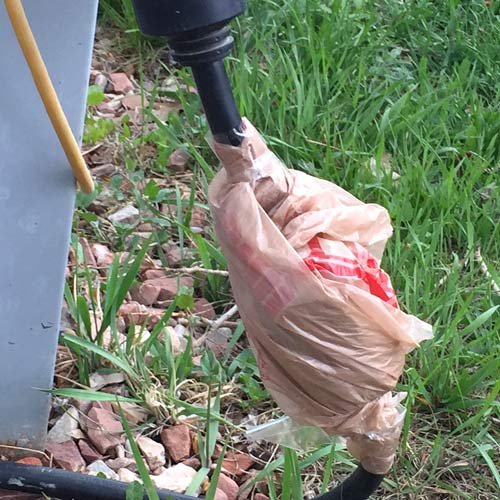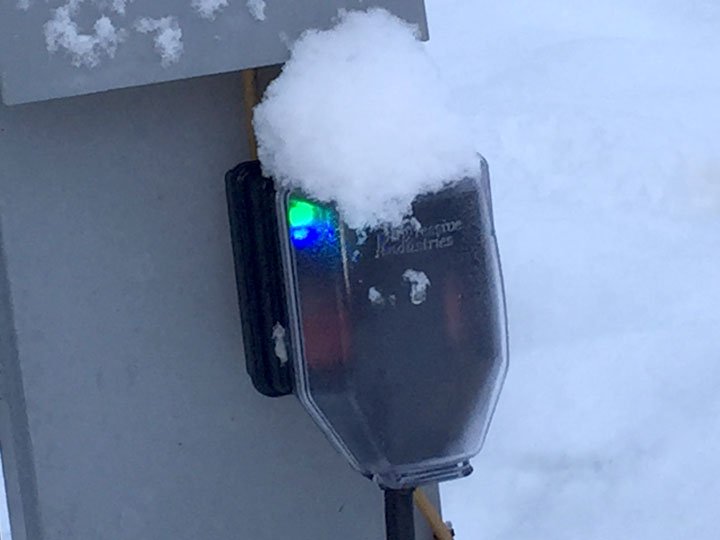I am always grateful for Live Work Dream readers who engage with us on our blog posts. I’d especially like to thank the engineers who comment with corrections, clarifications, detailed specifications, or helpful tips on my more technical posts. Recently, a couple of them encouraged me to get a certain job done right by replacing our RV surge protector, after I wrote about how to repair RV electrical cord – but apparently only addressed half the problem.
One tip in the comments on that post was to always cover the connections on your RV surge protector, which is something we always did. And yes, you should have an RV surge protector! I would always wrap our RV electrical cord with a plastic bag whenever camping with any sign of rain or snow.?
This reminded me of another winter weather RVing tip I shared long ago. When parked for any long duration, with stormy weather, I used half an old auto tire inner tube to protect the RV surge protector and electrical connections from getting wet in rain or snow.
Which brings me back to the more important suggestion from those comments of my recent post…
Prevent RV Electrical Damage with RV Surge Protector
Once I discovered there would be not enough cord remaining to repair our surge protector if I cut off the damaged outlet end, I realized it was time to get a new RV surge protector.
I hate being wasteful, almost as much as I hate spending money. But I would hate even worse to experience the repercussions of not having a good quality surge protector for the RV when we needed one. You never know when that might be, so it’s better to be prepared – and much better to be safe than sorry.
Once again, you get what you pay for. Our first entry level Surge Guard protector, cost in the $75 range. After hearing horror stories, and having our own close call, I was ready to step up our game. But hundreds of dollars are not in the budget right now for the best RV surge protection. We kicked it up one notch and got the Progressive Industries SSP-30XL Surge Protector.
Progressive Industries gets consistently positive reviews and frequent recommendations among RVers. The LED indicators immediately show the status of various wiring faults before plugging in your RV. I like that the built-in cover protects the connection from rain and snow. Which came in handy for the recent storm that covered our RV in snow during the (hopefully) last snowfall of spring in Colorado. No more plastic baggies at our campsite!





I think that the idea of covering electrical connections is a good idea. The EMS Units (Surge Protectors) are expensive. I suggest installing a hardwired one for a couple of reasons. One is to keep it out of the weather and the other is theft and loss that portable ones are prone to.
Although I am not an expect, but simply a lay person, I do feel I need to add one point, in layman’s terms, that was missed and it may be due to the fact that not all less expensive RV surge protectors do this. I have a expensive 50amp surge protector. It actually shuts off power to my RV if the voltage coming thru the pedestal is abnormal, then it recycles it’s start up procedure which takes about 30 seconds, checks the criteria of the power and then “clicks” on if the voltage is within the devices parameters. It won’t come back on if the voltage isn’t correct. So I think that as Steve pointed out, it won’t pass through the bad voltage. It goes thru the same process when we initially plug in upon arrival at a site. In rare situations, I have had to move to another site because the device will not allow electrical flow at that pedestal. Upon moving to another site everything is then okay. It’s totally automatic, all I do is plug it in.
Thanks for sharing!
The Progressive Industries units are not just “RV Surge (spike)” protectors. We have an EMS-50 hardwired model. They check that the connection is correct (L1, L2, N, and G) and that the voltage is within an acceptable tolerance of nominal (+ or -) before connecting power through to the coach. Even when everything looks OK, there is a 2min15sec delay before it lets the power flow through. If anything happens to change those conditions, such as an open neutral or ground, or high or low voltage, the EMS-50 will open the shorepower connection to the rig. Since air-conditioning or refrigerator compressors might have been operating when this happens, the unit waits 2min15sec before reconnecting power to allow the compressor head pressures to bleed down. Even then, it will only restore power if/when it determines that everything is back to normal. If, however, the electrical event was a true voltage spike, it might have destroyed components that are intended to be sacrificial under these circumstances.
I agree with Steve’s description. An electrical voltage “surge” is like a storm surge, a rise and fall that typically takes time. Most surge protectors are actually spike protectors, but they do not just protect the circuit using a capacitor (electrical storage device). They also contain fast-acting sacrificial components that will self-destruct in response to a true voltage spike (very high, very quick event) in order to cut off power to the rig. When this happens the rig is protected, but the “surge suppressor” now has to be replaced.
Thanks for the feedback!
Steve, There are many scholarly people in the electrical industry that disagree with most of your statements.
Like how Drew? It’s great to share all sides of the story.
Gosh Drew… I am a retired computer engineer and build my own electronics projects as a hobby. Pretty much everything Steve posted is true, in general. Yes, surge suppressors can be more complex in a few cases, but for the vast majority of them, he is dead on. Since your statement seems to indicate that you have some additional sources of electrical engineering knowledge, please enlighten all of us!
Being an engineer, the most comical part of my life is watching people react to the ‘fear mongering’ that the modern marketing circus has become. I’m not inferring that Jim is a victim, just that the public at large, certainly is. RV’ers are no exception. By first making you afraid of something unknown (and devastating), anyone can sell you something (more expensive and more easily).
The modern ‘surge protector’ scare started with computers. In an effort to protect the most expensive device they ever owned, people bought power strips with ‘surge protectors’ inside. Mind you, none of them could actually explain when or how this surge might occur, if it had ever occurred before owning the device, how the new device would protect their equipment, or if the equipment could protect itself. So, I thought I’d tag on to Jim’s post to shed some light.
‘Surges’ in electrical terms, are electricity flow above circuit design limits in either amperage or voltage. Amperage surges are caused by connected equipment drawing more than the circuit is able to supply. They are limited by fuses and breakers. Most importantly, an ‘amperage surge’ is not something that comes from the power supply and enters your RV.
The ‘surge’ that Jim’s protector is addressing is a ‘voltage spike’. This is typically a very short rise in voltage created by something like lightning striking the power system or, more often, a reactive piece of equipment on the distribution network, feeding back into the system. This voltage spike is kept from feeding into your local network (your RV) by the equipment inside the surge protector.
What is inside the surge protector is a capacitor. It is an electrical storage device that can be thought of as a small but quick acting battery. When plugged, in, the ‘battery’ charges to the line voltage in a second or two then just waits. When the high voltage of a spike comes by, the ‘battery’ sees the high voltage as an opportunity to charge and absorbs most of the excess, then discharge at a lower voltage over the next couple seconds. If the spike lasts a long time or is of sufficiently high energy, the ‘battery’ can’t absorb enough and it just passes through anyway. It’s important to understand that surge protectors don’t disconnect you from a network experiencing a dangerous event. They are simply ‘bouncers’, hoping to screen the riff-raff. If you have appliances operating during the spike THAT ARE SENSITIVE to it, you may have problems. Many of what you believe are ‘sensitive electronics’ are in fact, not all that sensitive because they have power supplies that convert multiple input voltages of AC into DC that are more capable than the so-called ‘surge protector’ to absorb and convert any input. New ‘switch mode’ power supplies are specifically much more tolerant whereas older ‘linear’ (transformer based) supplies are not.
When buying a product, be informed and be wary. Know what you are getting, how it works and what it is really doing. Only by being self-educating (not from a salesman) can you understand your need and get a product to fulfill it at a fair price.
I was expecting something like this…thanks again for the input!